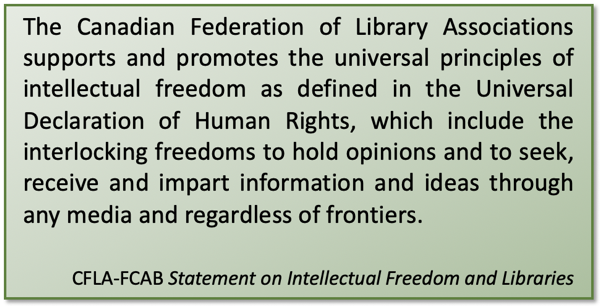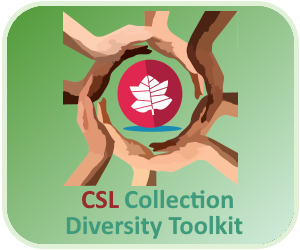 | 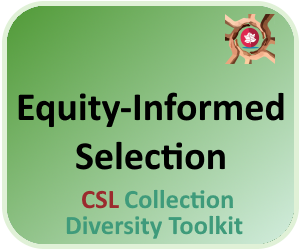 | 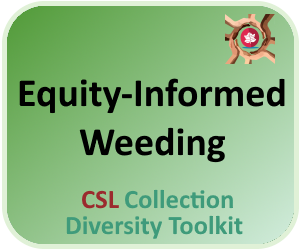 | 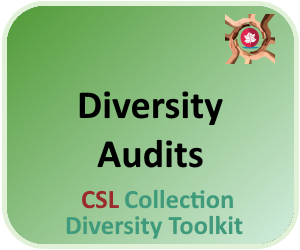 | 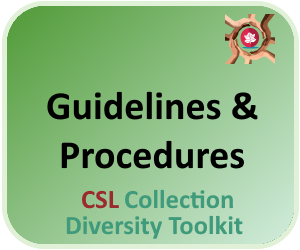 | 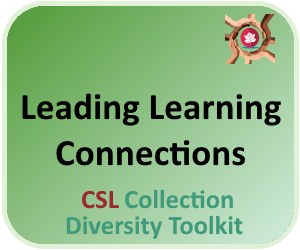 | 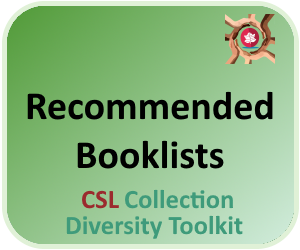 |

Selection Guidelines and Reconsideration Procedures
Key Questions
- How do the foundational values and ethics of librarianship and education guide how we select resources?
- How do library selection procedures support diversity and inclusion?
- What are the core values protected by strong selection and reconsideration procedures?
- How do selection and reconsideration procedures provide library professionals with confidence to develop diverse collections?
- Do you know the policies, procedures, and guidelines for selection and reconsideration in your jurisdiction?
Selection Guidelines & Reconsideration Procedures: Guiding Principles
Diverse collection development is a fundamental value of librarianship. Equity and inclusion are fundamental values in public education. Libraries and educational institutions typically have developed policies and guidelines about selection of resources, and reconsideration procedures for managing challenges to books and other resources.
Well-written guidelines defend universal principles of protecting intellectual freedom, and put collection diversity within the context of the rights and freedoms of all Canadians, as expressed in The Canadian Charter of Rights and Freedoms. The Charter protects the rights of everyone, including children.
The Mandate for Selection Guidelines
Librarianship: Protecting intellectual freedom is a foundational value of librarianship. In Canada, this is expressed in the Canadian Federation of Library Association’s Statement on Intellectual Freedom and Libraries.
“Libraries have a core responsibility to safeguard and facilitate access to constitutionally protected expressions of knowledge, imagination, ideas, and opinion, including those which some individuals and groups consider unconventional, unpopular or unacceptable. To this end, in accordance with their mandates and professional values and standards, libraries provide, defend and promote equitable access to the widest possible variety of expressive content and resist calls for censorship and the adoption of systems that deny or restrict access to resources.” (Statement on Intellectual Freedom and Libraries, CFLA-FCAB)
Education: It is the responsibility of ministries of education and/or school districts to develop selection guidelines for schools. It is extremely important that you use selection guidelines for your jurisdiction, and be familiar with associated procedures for reconsideration. Ministries of education may also provide guidelines in curriculum and policy documents with advice on educational resources. Some examples of education policies across the country include:
Ontario: In Ontario, the Ministry of Education requires school districts to develop their own guidelines and associated procedures for the selection of educational resources that are not on the ministry’s list of approved textbooks (The Trillium List, 2008). The policy guideline, Equity and Inclusive Education in Ontario Schools: Guidelines for Policy Development and Implementation (2014) supports principles of diversity and inclusion in the selection of educational resources.
Inclusive curriculum and assessment practices (p. 55)
- A board procedure is in place to assess learning materials for discriminatory bias.
- Resources and instructional strategies:
- are in compliance with the provisions of the Ontario Human Rights Code with respect to the prohibited grounds of discrimination;
- show people of different races, genders, and ages in non-stereotypical settings, occupations, and activities;
- explore the roles and contributions of all peoples in Canada, and the factors that shaped these roles;
- encourage open discussion of the prohibited grounds of discrimination under the Code (e.g., race, gender, disability, faith) in society, the community, and the school.
Saskatchewan: The Saskatchewan Ministry of Education (2008) provides guidance for selection and reconsideration in its document, Connections: Policy and Guidelines for School Libraries in Saskatchewan, specifically in Appendix C: Policies for Learning Resources – Selection of and Challenges to Learning Resources. The Connections policy document also supports diversity and inclusion in the selection of library resources.
Fostering Equity and Inclusion Learning materials play a significant role in shaping students’ views about the world. Therefore, it is important that the learning materials students use in school portray respect and dignity for both genders, those in specific cultural groups, people with differing physical and intellectual abilities, people of various ages, and people of differing gender orientation. In addition, students can see themselves, their families, and influences that shape their lives represented in the instructional resources available. The selection policy for the school division provides criteria to guide the selection of appropriate resources (see Appendix C). Resources in the school library collection reflect the perspectives, culture, and ways of knowing of Saskatchewan’s First Nations and Métis peoples to support student achievement of the outcomes of the provincial curriculum. All students benefit from gaining greater knowledge and increased understanding of Saskatchewan’s First Nations and Métis heritage and present-day realities.
(Connections: Policy and Guidelines for School Libraries in Saskatchewan, 2008)
British Columbia: The BC Ministry of Education (2017) requires school boards to create their own selection policies to ensure that the resources are locally appropriate. There is a provincial body, Focused Education (formerly ERAC), which uses qualified and practicing BC public school teachers to evaluate resources for the province, sharing their searchable K-12 Evaluated Resource Collection online.
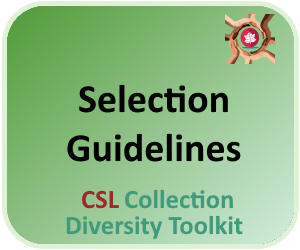
Components of Selection Guidelines
A jurisdiction’s selection document sets out expectations for educators. A good selection guideline provides the foundation for developing a diverse collection, based on sound principles. In school libraries, those guidelines should consider the role of resources in learning, and also provide guidance about representation and diversity.
Principles Supporting the Role of Resources in Learning: Resources in the school library should be selected based on:
- Relevance to the curriculum
- Student needs in terms of abilities, learning styles, and maturity
- The need for an information-rich environment so that students can learn the skill of informed decision-making
- The role of independent learning in the library, and the freedom to explore ideas
- Promote cross-curricular, holistic, and inquiry-based approaches to curriculum;
- Fostering collaborative and interactive learning
- Inclusion of multiple formats for information
- The need for resources that are low in commercialism
- Compliance with copyright law
Principles Supporting Representation and Diversity: Collectively, resources in the school library should represent:
- Diverse perspectives that reflect and are relevant to today’s world
- Diverse points of view about controversial issues, in order to develop skills of critical thinking
- The diversity of Canada’s religious, ethnic, and cultural groups and their contributions to Canadian society
- Indigenous perspectives and ways of knowing, free from elements that enable the exclusion of Indigenous peoples
- Individuals from diverse backgrounds, lifestyles, sexual orientation and gender identity or expression and portray gender, cultural and racial inclusiveness
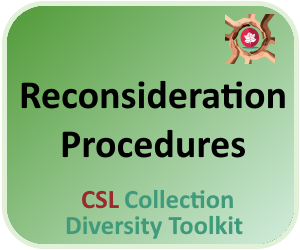
Reconsideration Procedures
Selection guidelines provide the foundation for developing a diverse collection, and also support educators in the event that a resource is challenged. It is extremely important that clear procedures are in place so that challenges are handled professionally and unemotionally. When procedures are clear and they are followed, it is rare for the challenge to result in the withdrawal of a resource. When procedures are subverted, for example in an attempt to avoid negative public attention, the rights of students to have access to diverse resources may also be subverted in the process.
When there is a news report about books being challenged in a school library learning commons, it is often because the item was removed at the direction of the school or district administration following a parent complaint about a specific book and that the proper ‘Request for Reconsideration’ process was not followed.
R. Beaudry, 2020. Censorship in Canadian Schools. Freedom to Read
Any member of the school community has the right to express a concern about a particular resource, and that concern should be taken seriously. Most concerns can be handled informally. For example, explaining that the student is free to return resources to the library and select something else may be all that is needed to deflect concern. Parents may provide guidance to their own children, but when a person challenges the inclusion of a resource in the library they are seeking its exclusion for all students.
If it is not possible to resolve the concern informally, the jurisdiction should have a clear procedure established for formal reconsideration. It is very important to be clear that the role of the reconsideration procedure is not to assess the resource in question according to the values of the challenger. Rather, concerns are considered on the basis of compliance with the principles for selecting and using resources as represented by the selection guideline document. In the formal procedure, the person or persons requesting reconsideration must demonstrate how the resource in question fails to comply with these established guidelines.
The challenge of materials should be viewed as an important and valuable part of the democratic and educational process. In Canada, when school or district guidelines for the reconsideration of controversial materials are followed, many challenged materials are retained. When censorship cases are considered by the courts, the outcome is most often retention of the materials.
Dr. Dianne Oberg. Freedom of Expression Rights and the School Library: Who Speaks for the Kids in Your School When the Censor Comes Calling? Freedom to Read
Reconsideration procedures may also provide guidance on the difference between selection and censorship. It should be made clear that resources are considered in their entirety, and not on sections or portions that may be taken out of context.
The reconsideration procedure defends the right of educators to select resources based on sound criteria. Resources being challenged should remain in circulation during the reconsideration process.
Confident Selection
The selection of library resources is a professional responsibility. With a strong selection guideline document and a clear reconsideration procedure, library professionals should feel confident in selecting a wide-ranging and diverse collection.
When selecting for a school library learning commons, strong selection procedures support collections that:
- Represent people of different races, genders, and ages in non-stereotypical settings, occupations, and activities;
- Represent the roles and contributions of all peoples in Canada, and the factors that shaped these roles;
- Share authentic voices from diverse groups, in order to accurately portray diverse cultural experiences, avoiding monolithic assertions and stereotypical portrayal
- Share a balance of viewpoints
- Widen student horizons and exposes them to ideas
- Avoid stereotypical or outdated material
Pressure for material inclusion or exclusion from individuals or groups should not be factored into material selection, but instead the professional judgement of a trained library professional should be applied, supported by guideline documents that defend universal principles of protecting intellectual freedom, and put collection diversity within the context of the rights and freedoms of all Canadians.
Librarians are not, and have never been neutral. They are human, and human beings are driven by conscious and unconscious bias. But rather than debate the point, let me posit we don’t want librarians to be neutral. We want librarians to work to make our communities better. We want our libraries to help communities make smarter decisions and to help community members find meaning.
The Battle for the Soul of the Library, by R. David Lankes, Scholar & Professor, author of The Atlas of New Librarianship, in response to the U.S. censorship crisis crippling school libraries in 2021-22.
More Resources
American Library Association Selection & Reconsideration Policy Toolkit for Public, School, & Academic Libraries: A comprehensive guide to creating selection and reconsideration resources for all library sectors.
Canadian Federation of Library Associations Statement on Intellectual Freedom and Libraries: This statement expresses the role that Canada’s libraries play in protecting intellectual freedom.
Canadian Federation of Library Associations Intellectual Freedom Challenges Survey: The survey creates a national snapshot of the nature and outcome of challenges to intellectual freedom in publicly-funded Canadian libraries. By documenting and reporting these incidents, Canadian libraries demonstrate their commitment to public accountability and institutional transparency.
Book and Periodical Council of Canada Freedom to Read: The Freedom to Read website provides many resources on censorship and free expression for students and educators.
Book and Periodical Council of Canada Freedom to Read Week: Held annually during February, Freedom to Read Week is an annual event that encourages Canadians to think about and reaffirm their commitment to intellectual freedom, which is guaranteed them under the Charter of Rights and Freedoms. Visit the website for resources for celebrating our freedom to read.
Exemplars
Toronto District School Board procedures: Selection and Approval of Learning Resources and Handling Concerns About Learning Resources and Controversial Issues.
Waterloo Region District School Board: Selection of Educational Resources: Selection Guideline, Reconsideration Procedure (2021)
School District No. 35, Langley, BC: Administrative procedure, Learning Resources.
Ontario Library Association: Sample Policy Concerning the Selection of School Library Materials: This document is intended as a resource to support school libraries in the development of selection policies which affirm the principles of intellectual freedom.
Ontario Library Association Forest of Reading® Policy on the Selection of Materials: The Forest of Reading program provides students in Ontario with lists of high quality Canadian reading material. The selection criteria on this page explains how the organization selects books for its lists. These criteria are ones that can equally be applied to school libraries as they show balance, forethought and attention to the needs of the readers in broadening their scope of experience. The points of consideration offered here are an excellent resource for understanding the why of libraries and material collection development that is robust and challenging.
 |  |  |  | ||
 |  |  |

